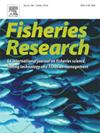Interannual variations in the size structure of swordtip squid Uroteuthis edulis in the southern East China Sea
IF 2.2
2区 农林科学
Q2 FISHERIES
引用次数: 0
Abstract
Identifying the population structure of commercially exploited fish species is essential for effective fisheries management. These insights are particularly important for short-lived squid, which often exhibit considerable variations in life history traits. The swordtip squid (Uroteuthis edulis) inhabits temperate and tropical neritic waters of the Indo-Pacific regions, and is harvested using diverse fishing gears and methods throughout its distribution range. Two seasonal cohort of swordtip squid on the southern East China Sea (ECS) shelf have been identified, each exhibit distinct growth patterns. However, information on the size structures of the seasonal cohorts on the southern ECS shelf remains limited. In this study, we examine the size groups and associated life history traits of swordtip squid in the southern ECS during 2021–2022. Swordtip squid were categorized into large-sized (LS) and small-sized (SS) groups based on natural breaks in the distribution of mantle length for each sex at each sexual maturity stage. The LS group hatched in winter and matured (spawned) in spring-summer, whereas the SS group hatched in summer and matured (spawned) in autumn-winter. The two size groups likely alternated between generations. Notably, some individuals hatched in the same season but developed into different size groups, suggesting the possibility of exposure to varying environmental conditions. These results imply the spawning sites for swordtip squid are widespread in the southern ECS, likely driven by major oceanographic processes that vary seasonally and interannually. Our findings clarify the population structure of swordtip squid on the southern ECS shelf and may facilitate conservation and management measures for the fisheries in the Northwest Pacific region.
求助全文
约1分钟内获得全文
求助全文
来源期刊

Fisheries Research
农林科学-渔业
CiteScore
4.50
自引率
16.70%
发文量
294
审稿时长
15 weeks
期刊介绍:
This journal provides an international forum for the publication of papers in the areas of fisheries science, fishing technology, fisheries management and relevant socio-economics. The scope covers fisheries in salt, brackish and freshwater systems, and all aspects of associated ecology, environmental aspects of fisheries, and economics. Both theoretical and practical papers are acceptable, including laboratory and field experimental studies relevant to fisheries. Papers on the conservation of exploitable living resources are welcome. Review and Viewpoint articles are also published. As the specified areas inevitably impinge on and interrelate with each other, the approach of the journal is multidisciplinary, and authors are encouraged to emphasise the relevance of their own work to that of other disciplines. The journal is intended for fisheries scientists, biological oceanographers, gear technologists, economists, managers, administrators, policy makers and legislators.
 求助内容:
求助内容: 应助结果提醒方式:
应助结果提醒方式:


